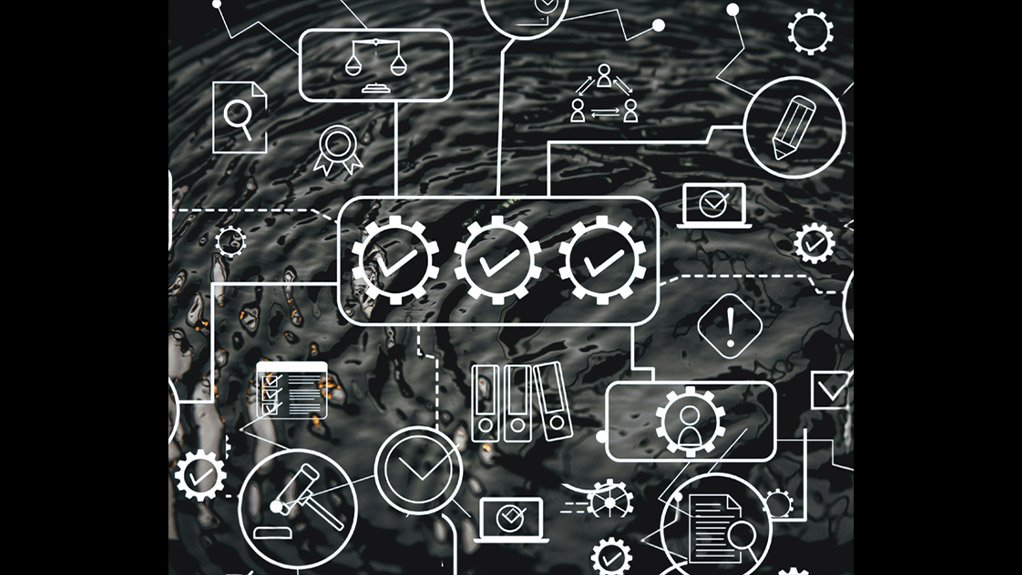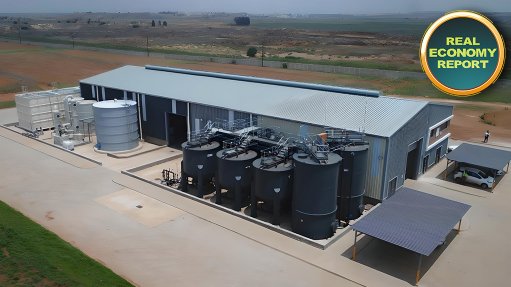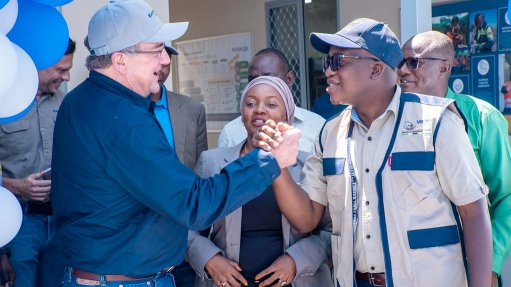Intention to Revise the General Authorisation (GA) in terms of Section 39 of the National Water Act, 1998 (Act no. 36 of 1998) for water uses as defined in Section 21(c) or (i) and its implications
This article has been supplied as a media statement and is not written by Creamer Media. It may be available only for a limited time on this website.
(Virtual Showroom): The Director-General of the Department of Water and Sanitation (DWS) published Notice No. 3139 titled “Revision of General Authorisations in terms of Section 39 of the National Water Act, 1998 (Act no. 36 of 1998) for water uses as defined in Section 21(c) or Section 21(i)” in Government Gazette (GG) No. 48187 on the 10th March 2023 for a sixty (60) day public comment period. Should you wish to provide comment GG No. 48187, which includes Notice 3139 on page 108 can be accessed from the following link: https://www.gov.za/documents/national-water-act-revision-general-authorisations-water-uses-comments-invited-10-mar-2023. Members of the public who wish to submit their comments are requested to do so via Post to Private Bag X313, Pretoria, 0001, or via email to Dr. Wietsche Roets at RoetsW@dws.goc.za. All comments must be marked for the attention of the Specialist Scientist: Water Abstraction and Instream Impact: Dr. W. Roets.
Once finalised, Notice No. 3139 will replace Notice No. 509 titled “General Authorisation in terms of Section 39 of the National Water Act, 1998 (Act No. 36 Of 1998) for water uses as defined in Section 21(C) or Section 21(I)”, which was published in GG No. 40229 on the 26th August 2016. This is in line with Section 4(a) of Notice No. 509 (DWS, 2016).
The purpose of the article is to highlight the primary revisions that have been included in Notice No. 3139 in comparison to the existing Notice No. 509 for ease of reference. In addition to this, the implications of the potential revisions will be discussed to provide insight on how Notice No. 3139 may affect the General Authorisation process for Section 21(c) and (i) water uses. This may guide public comment on the proposed revisions to Section 21(c) and (i) revisions. It must be reiterated that Notice 3139 (DWS, 2023) has not yet been finalised, and thus is subject to change.
Summary of Revisions:
The following provides a summary of the revisions made to Notice No. 509 (DWS, 2016) that have been amended in Notice No. 3139 (DWS, 2106) for ease of reference:
Paragraph 2: Definitions Revised
Emergency Incident
Emergency Situation
Hazardous added to definitions
Impeding
Maintenance
Regulated area of a watercourse (b)
Reportable incident
Resource quality
Responsible authority
River management plan
Paragraph 3: Exclusion to this Notice
Amended Paragraph 3(e): Clarity provided that internal sewerage reticulation in residential developments, including minor sewerage connections to main sewers, are not excluded from Notice No. 3139, provided that flow in the pipelines is below the 120 Litres (l) / Second (s) threshold. This will allow smaller sewerage reticulation pipelines and connections to apply for a GA, as opposed to a full Water Use License (WUL) if the risk is determined to be Low in the Risk Assessment Matrix (RAM).
Added Paragraph 3(f) Section 21(c) and (i) water use associated with construction of water and wastewater treatment works.
Added Paragraph 3(g) Section 21(c) and (i) water use associated with any hazardous material within the Regulated Area of a watercourse.
Added Paragraph 3(h) Section 21(c) and (i) water use associated with mining activities and associated infrastructure unless it falls within Appendix D2.
Provision has been made to deal with emergency incidents and accidents related to sewerage and hazardous material infrastructure, or any of the above exclusions in terms of Paragraph 6(vi) of Notice No. 3139, which requires for the Emergency Protocol stipulated in Appendix C to be implemented.
Added “where the water use falls within paragraph 3(b) – (h) a full WULA will be required”.
Paragraph 4: Duration of Notice
Notice will be valid from the date that Notice No. 3139 comes into effect, as opposed to Notice No. 509 which states the validity period will commence from the date of publication.
Paragraph 5: Area of Applicability of Notice
No change, applicability remains in the Republic of South Africa and the Regulated Area of a watercourse.
Paragraph 6: To whom this Notice if Applicable
Paragraph 6(i) Activities stipulated within Appendix D1 are Generally Authorised without the need to undertake a RAM, provided that Conditions 8-16 presented in Notice No. 3139 are met. The activity listed in Appendix D1 have been amended to include several additional activities. This has been discussed in sections to follow.
Paragraph 6(v) River and stormwater management activities including maintenance of infrastructure as contained within a river management plan, or similar, can only be conducted once the river management plan, to be drafted in accordance with Appendix B, has been approved by regional DWS. The plan must then be implemented in terms of a GA and registered as such.
Paragraph 6(2) All State-Owned Entities (SOEs) specified in Appendix D2 may use water in terms of Section 21(c) and (i) without being subject to a RAM, but must comply with Conditions 8-16 of Notice No. 3139. The SOEs listed in Appendix D2 have been amended to include several entities. This has been discussed in sections to follow.
Paragraph 6(3) A water user which uses water in terms of GA 1 and 2 to the schedules of Notice 398, GG No. 26187 (26 March 2004), GA 1199, GG No. 32805 (18 December 2009) and GA 509, GG No. 40229 (26 August 2016) may continue such water use without the requirement of re-registering. All existing GAs remain in place, subject to the conditions presented therein.
Paragraph 7 previously titled “Assessment of Risk and Mitigation Factors” in Notice No. 509 (DWS, 2016) has been presented as a table in Notice No. 3139 (DWS, 2023) in which the minimum document submission requirements for registration have been specified, which include: a) A Master Layout Plan, b) Relevant registration forms, c) Completed RAM as per Appendix A which must be completed by a SACNASP professional member and d) Any applicable information to substantiated assessment. The table also presents the spreadsheets and tools that must be used during the Risk Assessment process, which has not changed from Notice No. 509 (DWS, 2016). However, the RAM spreadsheet stipulated under Appendix A of Notice No. 509 (DWS, 2016) has been amended. This has been discussed in sections to follow.
Paragraph 8 of Notice No. 509 (DWS, 2016) titled “Assistance to people with special needs” has been removed in Notice No. 3139 (DWS, 2023).
Paragraph 7 (Previously Paragraph 9 in Notice No. 509 (DWS, 2016)): Conditions for impeding or diverting the flow of water or altering the bed, banks, course of characteristics of watercourse in terms of Notice No. 3139
Paragraph 9(c) presented in Notice No. 509 (DWS, 2016), which states that full financial provision for the implementation of the management measures prescribed in Notice No. 509 (DWS, 2016), has been removed in Notice No. 3139 (DWS, 2023). This will no longer be a requirement.
Paragraph 7(2) Water users will only need to ensure that all persons entering the site, including contractors and casual labour, are made aware of Conditions presented in paragraphs 7 to 9 of Notice No. 3139 (DWS, 2023). This is a change from Notice No. 509 (DWS, 2023) which implies that all persons and contractors must be made aware of all conditions and related management measures specified in the aforementioned Notice.
Paragraph 9(m) has been amended to include the capturing of dated photographs before, during and after the completion of any works, including emergency structures and rectification of reporting incidents. The requirement for water users to measure weekly water quality parameters during the construction phase, as stipulated within Notice No. 509 (DWS, 2016), has been moved to Paragraph 9 in Notice No. 3139 (DWS, 2023). This Paragraph is discussed in sections to follows.
Paragraphs 9(n) to (p) previously presented in Notice No. 509 (DWS, 2016) have been removed in Notice No. 3139 (DWS, 2023), thus reducing the conditions that will need to be complied with by the water user under Notice No 3139.
Paragraph 8 (Previously Paragraph 10 in Notice No. 509 (DWS, 2016)): Rehabilitation
Paragraph 8(2) Post-construction activities (i.e. rehabilitation) includes maintenance activities under Notice No. 3139 (DWS, 2023), which was previously omitted in Notice No. 509 (DWS, 2016).
Paragraph 8(2)(d) has been added, which states that “the Master Layout Plan as was used during the risk assessment must ensure “Design with Nature” principles by excluding sensitive area, providing erosion protection, upkeep and maintenance of structures”. This essentially means that the Master Layout Plan should consider the post-construction environment and make mention of the proposed avoidance, upkeep and maintenance of the receiving environment.
Paragraph 9 (Previously Paragraph 11 in Notice No. 509 (DWS, 2016)): Monitoring and Reporting
Paragraph 9(1) has been amended to state that water users must determine the instream baseline water quality for pH, Electrical Conductivity (EC), Total Dissolved Solids (TDS), Total Suspended Solids (TSS), Turbidity, Temperature and Dissolved Oxygen (DO) weekly for one (1) month before commencement of the water use. Dated photographic recorded of sample sites must be captured. In addition to this, the water users must collect water quality samples weekly during construction both upstream and downstream of the activity. This must continue until baseline values have been achieved. Baseline water quality levels and other resource quality characteristics must be reached and maintained during post-construction and rehabilitation phases. This puts an onus on the water user to ensure that water quality does not deteriorate as a result of the activity.
Paragraph 2(b) stipulated in Notice No. 509 (DWS, 2016) stating that the water user must “appoint a competent person to assess the water use managements made in terms of this GA and submit the findings to the responsible authority for evaluation” has been amended in Paragraph 3(b) of Notice 3139 (DWS, 2023) by removing “appoint a competent person”. This can be interpreted as the water user being able to assess the water use managements made.
Paragraph 3(c) has been added, stating that the water user must ensure that environmental audits are conducted. No requirement in terms of audit frequency has been included.
Paragraph 3(d) has been added, stating that all findings applicable to requirements stipulated under Paragraph 3 must be submitted electronically as stipulated under Paragraph 12 to be discussed in later sections.
Paragraph 4 has been amended to exclude the requirement of environmental audits being required annually for three (3) years after the completion of the construction activities. Under Notice 3139 (DWS, 2023), only one (1) post-construction environmental audit must be conducted within six (6) months of completion of construction activities and the audit must be conducted by a suitably qualified person. If the findings of the environmental audit indicate that further remediation work is required, these must be implemented accordingly.
Paragraph 10 (Previously Paragraph 12 in Notice No. 509 (DWS, 2016)): Budgetary Provisions
No changes have been made to this section.
Paragraph 11 (Previously Paragraph 13 in Notice No. 509 (DWS, 2016)): Registration
Paragraph 11(1) has been amended to state that “new water users must submit the relevant registration forms…”, as opposed to Notice No. 509 (DWS, 2016) which states that “a person who uses water as contemplated in [Notice No. 509] must submit the relevant registration forms…”. This can be interpreted as water users that already have a GA do not have to re-register.
Paragraph 11(2) has been amended to state that “the responsible authority must provide confirmation of registration to the water user within 30 working days of the responsible authority being satisfied that the submission complies with all the requirements of [Notice No. 3139]”.
Paragraph 12 (Previously Paragraph 14 in Notice No. 509 (DWS, 2016)): Record-keeping and Disclosure of Information
Paragraph 12(1) states that subject to Paragraphs 9(1) and 9(2) of Notice No. 3139 (DWS, 2023) (relating to water quality monitoring and the establishment and implementation of a monitoring programme), the water user must now keep written record of monitoring results and supporting documents related to the activity and related risks, which must be made available upon inspection or written request.
Paragraph 12(2) now requires for the water user to register on www.dws.gov.za/dir_ws/wsmenu and upload all documents applicable to the full project lifecycle including baseline water quality data and monthly monitoring data against baseline on the departmental Integrated Regulatory Information System (http://ws.dwa.gov.za/IRIS.aspx).
Paragraph 13 (Previously Paragraph 15 in Notice No. 509 (DWS, 2016)): Inspection
Any property in respect to which a water use has been registered in subject to inspection as contemplated in Sections 124 and 125 of the National Water Act, 1998 (Act no. 36 of 1998).
Paragraph 14: Offences
This paragraph has been added as no direct mention of offences is stipulated within Notice No. 509 (DWS, 2016). It states that a person who contravenes any provision of [Notice No. 3139] is guilty of an offence as set out in Section 151(1) of the [National Water Act, 1998 (Act no. 36 of 1998)] and is subject to the penalty set out in Section 151(2) of the [National Water Act, 1998 (Act no. 36 of 1998)].
Paragraph 15 (Previously Paragraph 16 in Notice No. 509 (DWS, 2016)): Compliance with this Notice, the Act, Regulations under the Act and other laws
Paragraph 15 places a clearer responsibility in terms of Notice No. 3139 for the water user, and not any other person or body, to comply with the provisions presented therein.
Paragraph 16 now clarifies that an authorisation granted under Notice No. 3139 does not exempt a person who uses water from compliance with any provision of the [National Water Act, 1998 (Act no. 36 of 1998)] unless otherwise stated in [Notice No. 3139], or any other applicable law, regulation, ordinance of bylaw.
Appendix A: Risk Assessment Matrix (RAM)
The new RAM spreadsheet will separate the severity scoring for Geomorphology and Habitat, which is currently assessed together under Notice No. 509 (DWS, 2016).
The requirement to assess “legal issues” as required under Notice No. 509 (DWS, 2016) has been removed from the updated RAM spreadsheet stipulated within Notice No. 3139 (DWS, 2023). This is presumably as a result of the RAM only being triggered if a Section 21(c) and (i) water use falls within the Regulated Area of a watercourse, and thus there is no need to assess the legal issues. The overall significance rating for each aspect will therefore not consider legal issues within the updated RAM template.
In comparison to the current RAM spreadsheet, in which only the negative severity is scored, the updated RAM will also make provision for the scoring of positive scoring for those aspects which will improve the current condition (e.g. rehabilitation and maintenance).
At present, the risks to resource quality are only calculated considering the post-mitigation scoring (i.e. considering all mitigation and rehabilitation measures as recommended). However, the updated RAM spreadsheet will require for both pre- and post-mitigation scoring of risk aspects to be conducted for the construction and operational phases.
Appendix D1: Activities that are Generally Authorised for any person subject only to compliance with conditions 8-16 of [Notice No. 3139] (No requirement for a RAM).The following activities have been added to Appendix D1, and thus will be Generally Authorised without the requirement for a RAM to be conducted:
Any landowner: Construction of a single residential house and associated infrastructure (including sewer connections below 120l/s, conservancy tanks or French drains provided the sewerage disposal infrastructure is at least 100 m from any watercourse)
Any person: Construction of Renewable Energy Projects Solar and Wind with a generating capacity of 100mW or below that: Will not result in any direct destruction of any watercourses and where the sewerage infrastructure are located outside the regulated area of a watercourse. Where there will be any direct impacts/destruction of any watercourses the entire project must be subjected to a comprehensive Risk Matrix Assessment to determine the appropriate entitlement for the project.
Any person: Mini scale hydropower developments with a maximum capacity of 10kW 300kW. (Read together with General notice 665 of 6 Sept 2013 General Authorisation section 21 (e) or as amended) These hydropower plants will provide basic, non-grid electricity to rural communities and agricultural land and must in no way affect the flow regime, flow volume and/or water quality including temperature.
Appendix D1: Activities listed that are Generally Authorised for institutions subject only to compliance with conditions 8-16 of [Notice No. 3139] (No requirement for a RAM).The following activities have been amended in Appendix D2, and thus will be Generally Authorised without the requirement for a RAM to be conducted:
ESKOM: The following has been amended “Construction of new overhead transmission and distribution power lines outside the active channel of a river and/or outside the extent of a wetland, and minor maintenance of roads, river crossings, towers and substations where footprint will remain the same. The maintenance or replacement of existing overhead and underground cables where it is done in terms of the Emergency Protocol. However, New underground cables and underground and overhead cables within the extent of a wetland must be subjected to the Risk Matrix and are therefore excluded from this appendix.”
SANPARKS and provincial conservation agencies: The automatic authorisation of bridges and low water bridges has been removed. Under Notice No. 3139, only the contraction and maintenance of all pipelines (including sewerage) below 500 mm in diameter will be Generally Authorised without the need for a RAM to be conducted.
SANRAL: All maintenance of bridges over rivers, streams and wetlands and construction of bridges over non-perennial rivers done according to SANRAL Drainage Manual or similar norms and standards. For these linear projects where any other part of the project constitute a section 21 (c) or (i) water use the Risk Matrix must be applied and could result in the entire project being authorised under one authorisation, either a GA or a WUL if “risks” are moderate or high, and are therefore excluded from this appendix.
Gautrain Management Agency: Maintenance of existing infrastructure and expansion to crossings of non-perennial rivers within the existing servitude. Bridges crossing any other watercourses must be subjected to a risk matrix to determine the appropriate entitlement. For these linear projects where any other part of the project constitutes a Section 21 (c) or (i) water use the Risk Matrix must be applied and could result in the entire project being authorised under one authorisation, either a GA or a WUL if “risks” are moderate or high and are therefore excluded from this appendix.
Telkom and all other communications companies: The following has been amended “Installation of all cables where watercourses are crossed by Horizontal Directional Drilling or pipe jacking and/ or conventional installation (trenching) of cables crossing rivers or passing through the regulated area of a wetland or pan but outside the extent of the wetland or pan. However, conventional installation of cables through the extent of a wetland or pan must be subjected to the Risk Matrix and are excluded from this appendix”.
Rand Water: The following has been amended “All maintenance of existing water pipelines and construction of new water pipelines 1.5 m diameter and smaller crossing non-perennial rivers and wetlands outside delineated wetland boundary or extent. Pipelines crossing any other watercourses (within the extent/boundary of wetlands or pan) must be subjected to the Risk Matrix and could result in the entire project being authorised under one authorisation, either a GA or a WUL if “risks” are moderate or high, and are therefore excluded from this appendix”.
Lessee of state land around government waterworks (state dams): The following activity was added: “Construction or maintenance of floating jetties (temporary and permanent) and slipways. Constructed jetties other than floating are excluded from this appendix and must be subjected to the Risk Matrix”.
Control of Alien Invasive Species or control of Indigenous Species encroachment: The following activity was added: “1) When the control will be executed, monitored and reported in terms of a control plan as approved by the relevant regional office or CMA. 2) Release of approved biological control agents for alien invasive aquatic weeds.
The proposed revisions to the GA in terms of Section 39 of the National Water Act, 1998 (Act no. 36 of 1998) for water uses as defined in Section 21(c) or (i) will have implications on the activities that can be Generally Authorised, and the manner in which the authorisation process and requirements thereof will be undertaken. ENVASS has considerable experience with undertaking GA and WULA processes, as well as specialist studies and RAMs applicable to Section 21 of the National Water Act, 1998 (Act no. 36 of 1998).
Comments
Press Office
Announcements
What's On
Subscribe to improve your user experience...
Option 1 (equivalent of R125 a month):
Receive a weekly copy of Creamer Media's Engineering News & Mining Weekly magazine
(print copy for those in South Africa and e-magazine for those outside of South Africa)
Receive daily email newsletters
Access to full search results
Access archive of magazine back copies
Access to Projects in Progress
Access to ONE Research Report of your choice in PDF format
Option 2 (equivalent of R375 a month):
All benefits from Option 1
PLUS
Access to Creamer Media's Research Channel Africa for ALL Research Reports, in PDF format, on various industrial and mining sectors
including Electricity; Water; Energy Transition; Hydrogen; Roads, Rail and Ports; Coal; Gold; Platinum; Battery Metals; etc.
Already a subscriber?
Forgotten your password?
Receive weekly copy of Creamer Media's Engineering News & Mining Weekly magazine (print copy for those in South Africa and e-magazine for those outside of South Africa)
➕
Recieve daily email newsletters
➕
Access to full search results
➕
Access archive of magazine back copies
➕
Access to Projects in Progress
➕
Access to ONE Research Report of your choice in PDF format
RESEARCH CHANNEL AFRICA
R4500 (equivalent of R375 a month)
SUBSCRIBEAll benefits from Option 1
➕
Access to Creamer Media's Research Channel Africa for ALL Research Reports on various industrial and mining sectors, in PDF format, including on:
Electricity
➕
Water
➕
Energy Transition
➕
Hydrogen
➕
Roads, Rail and Ports
➕
Coal
➕
Gold
➕
Platinum
➕
Battery Metals
➕
etc.
Receive all benefits from Option 1 or Option 2 delivered to numerous people at your company
➕
Multiple User names and Passwords for simultaneous log-ins
➕
Intranet integration access to all in your organisation





















